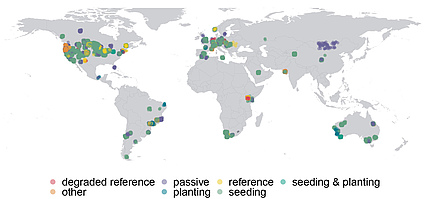SynFlex - Insights into a flexible synthesis funding mechanism
The Global Restore Project is our effort to compile community vegetation responses to disturbance, the ending of disturbance, and active ecological restoration treatments such as seeding and planting trees. We want to share knowledge to inform shared success in the United Nations Decade on Ecosystem Restoration. I started out by writing an Alexander von Humboldt Foundation grant application for a 24 month postdoc fellowship, shortly after arriving at iDiv as a Flexpool funded postdoc with Jon Chase and Stan Harpole (Flexpool is iDivs internal funding mechanism to foster collaborations within the consortium). I proposed to ask questions about community assembly and the functioning of ecosystems, as well as look at measurements of biodiversity across scales in disturbed and restored communities and metacommunities.
Shortly after getting started, someone told me that Nancy Shackelford, a postdoc at University of Colorado Boulder, was working on something similar. I reached out, and Nancy explained she was compiling data like this only within the world’s drylands in the Global Arid Zone Project. I proposed to complete the precipitation gradient, and we agreed to collaborate and call our joint collaboration the Global Restore Project. We’ve been embracing the variety of ways that restoration gets done in the field. This means we have collected a variety of datasets that answer a variety of different questions. This also means, compiling and managing these data is a lot of work.
This project successfully has had ongoing support from the Alexander von Humboldt Foundation and Jon Chase’ Biodiversity Synthesis group. Since then, Nancy Shackelford has become an Assistant Professor and Director of the Restoration of Natural Systems Program at University of Victoria in Canada and has been supporting us from there. When sDiv announced their SynFlex funding scheme during the 9th call, this sounded like a scheme that could help support our project. The idea was that SynFlex proposals didn’t have to be a ‘working group’, you could request for a variety of flexible support mechanisms for synthesis projects. Jon Chase and I decided to propose the next phase of our project; to better integrate data from Europe and to begin networking towards integrating regions currently underrepresented in the GRP, including parts of the Global South. To do so, we also engaged with the amazing support of iDiv experts Helge Bruelheide, Ute Jandt, Tiffany Knight and Stan Harpole. Our proposal sReStoReS (Restoration Synthesis to Reimagine Success) was successful ;) . With this support we hired Jack Boyce — a Masters student in the Joint International Master in Sustainable Development Program at Leipzig University — as research support for the next phase of the GRP.
Together, Jack has helped us find, request and compile new data with a focus on underrepresented regions within our database. Jack works with data contributors to help get their data to us and formatted for the database. He manages our data, keeps records of all requests, uses R to normalize taxonomy across the database, and ultimately processes the data into our harmonized structure. Together, we have grown the database to surpass over 200 datasets across almost 2000 unique sites. Jack has now started his Masters project with iDiv colleague Nadja Rüger in iDivs Biodiversity Economics group where he explores management options to promote biodiversity conservation in the Leipzig Floodplain Forest. He will continue to work with the GRP, sDiv, the Biodiversity Synthesis and Biodiversity Economics groups until next year. The sDiv SynFlex flexible funding mechanism helped give our project the research support it needed for our long-term vision, without explicitly needing to fund meetings and working group members to fly here.
The GRP is supporting sDiv working groups sToration, sPriority, and sFutures with data for synthesis, each looking at restoration outcomes from completely different and interdisciplinary angles. We have some amazing Masters, PhD students, and Postdocs engaged with the project using the data to ask different questions. We plan to finish the first phase soon and publish an open access data paper, so that anyone can use the data and cite the source. Our vision for this project is long-term. We intend to continue to work with restoration researchers and practitioners to understand context-dependence and generality in ecological restoration from a variety of angles.
If you have or know of interesting datasets that might contribute to this effort, please don’t hesitate to reach out to me or to any of our team members!
Cited literature
Ladouceur, E., Shackelford, N., Bouazza, K., Brudvig, L., Bucharova, A., Conradi, T., Erickson, T. E., Garbowski, M., Garvy, K., Harpole, W. S., Jones, H. P., Knight, T., Nsikani, M. M., Paterno, G., Suding, K., Temperton, V. M., Török, P., Winkler, D. E., & Chase, J. M. (2022). Knowledge sharing for shared success in the decade on ecosystem restoration. Ecological Solutions and Evidence, 3, e12117. https://doi.org/10.1002/2688-8319.12117
Shackelford, N., Paterno, G.B., Winkler, D.E. et al. (2021). Drivers of seedling establishment success in dryland restoration efforts. Nat Ecol Evol 5, 1283–1290. https://doi.org/10.1038/s41559-021-01510-3

